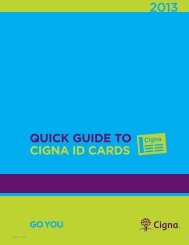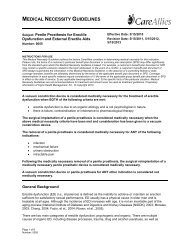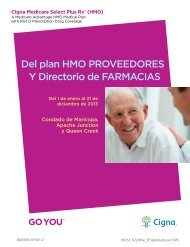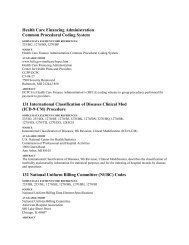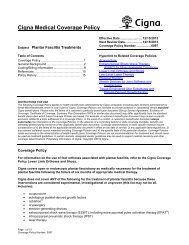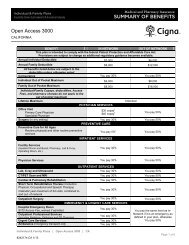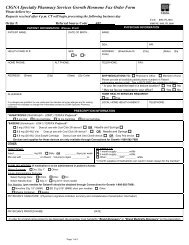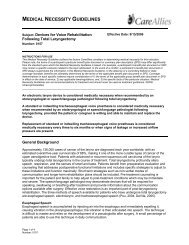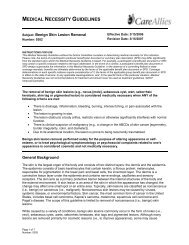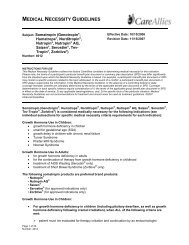Electrical Stimulators - Cigna
Electrical Stimulators - Cigna
Electrical Stimulators - Cigna
Create successful ePaper yourself
Turn your PDF publications into a flip-book with our unique Google optimized e-Paper software.
Rhodes Index of Nausea, Vomiting and Retching total experience was significantly better in the acustimulation<br />
group compared to the sham group (p=0.02). At the end of the 21-day trial, weight gain was significantly greater<br />
in the study group compared to the sham group (p=0.003). Occurrences of dehydration secondary to nausea<br />
and vomiting were significantly fewer in the acustimulation group compared to the sham group (p=0.013). There<br />
were no significant differences between the groups in medication usage or urinary ketones. The authors noted<br />
that the study “did not have sufficient power to assess whether efficacy of the device was related to gestational<br />
age at enrollment.” Other limitations of the study include the short-term use of the device, and a drop out rate of<br />
18.6%.<br />
Threshold/Therapeutic <strong>Electrical</strong> Stimulation (TES)<br />
TES is the application of a low level current (2–10 milliamps) to the muscles in the body. It is typically applied at<br />
home while the patient is sleeping, for 8–12 hours per night, for up to six nights a week, for years. Researchers<br />
have proposed the use of TES for decreasing neuromuscular spasms that result from involuntary muscle<br />
contractions in patients with motor disorders (e.g., cerebral palsy, spina bifida). Proposed outcomes of TES<br />
include: improved muscle strength, decreased spasticity, increased joint mobility, and improved bowel and<br />
bladder dysfunction. It is also proposed as a treatment option for scoliosis.<br />
U.S. Food and Drug Administration (FDA): TES devices are approved as 510(k) FDA Class II devices. The<br />
NT200-TES (Bio-Medical Research LTD, Laurel, MD) is an example of an approved device.<br />
Literature Review: The exact mechanism by which threshold electrical stimulation (TES) might improve motor<br />
function in children with cerebral palsy or other motor disorders is unclear. Study results are conflicting<br />
regarding the potential benefit of TES. There is insufficient published peer-reviewed scientific literature to<br />
support TES in the treatment of cerebral palsy or other motor disorders.<br />
Kerr et al. (2006) conducted a randomized, placebo-controlled trial to assess the efficacy of NMES and TES in<br />
strengthening quadriceps muscles of both legs in 60 children with cerebral palsy (CP) with diplegia. The children<br />
were randomized into one of three groups: NMES (n=18), TES (n=20), or placebo (n=22). Outcome measures<br />
included peak torque of the left and right quadriceps muscles, gross motor function, and impact of disability.<br />
They were assessed at baseline, at a six week follow-up visit, and at the end of treatment (16 weeks). No<br />
statistically significant difference was noted for NMES or TES versus placebo for strength or function.<br />
Statistically significant differences were noted between NMES and TES versus placebo for impact of disability at<br />
the end of treatment, but only between TES and placebo at the six week follow-up. The authors noted that<br />
further evidence is required to establish the role of NMES and TES as an adjunct therapy, to define patient<br />
populations that would benefit from NMES and TES and to determine the appropriate dosing parameters.<br />
Dali et al. (2002) conducted a randomized controlled trial to determine whether a group of stable children with<br />
CP (i.e., 36 males, 21 females; mean age 10; age range 5–18) would improve their motor skills after 12 months<br />
of TES. Two-thirds received active and one-third received inactive stimulators. Tests were videotaped and<br />
assessed blindly to record qualitative changes that might not be reflected in performance measurements. Range<br />
of motion, degree of spasticity, and muscle growth measured by computed tomography (CT) were evaluated.<br />
Fifty-seven of 82 outpatients who were able to walk at least with a walker completed all 12 months of treatment<br />
(hemiplegia [n= 25]); diplegia [n= 32]). There was no significant difference between active and placebo<br />
treatment in any of the study groups. Visual and subjective assessments favored TES, whereas objective<br />
indices showed the opposite trend. The authors concluded that TES in these CP patients did not have any<br />
significant clinical effect during the test period and that additional studies are needed to establish whether or not<br />
TES causes improvement in children with other movement disorders than the children with hemiplegia and<br />
diplegia in this study.<br />
Summary<br />
Neuromuscular electrical stimulation (NMES) is an established therapy for the treatment of disuse atrophy when<br />
the nerve supply to the atrophied muscle is intact and NMES is used as one component of a comprehensive<br />
rehabilitation program.<br />
Although there is limited evidence in the published peer-reviewed scientific literature to support transcutaneous<br />
electrical nerve stimulators (TENS) for the treatment of patients with chronic pain, TENS is an established<br />
treatment modality for this indication when conventional therapy has been tried for three months and failed.<br />
TENS is also supported for the treatment of pain in the immediate post-operative period following surgery (i.e.<br />
Page 23 of 41



